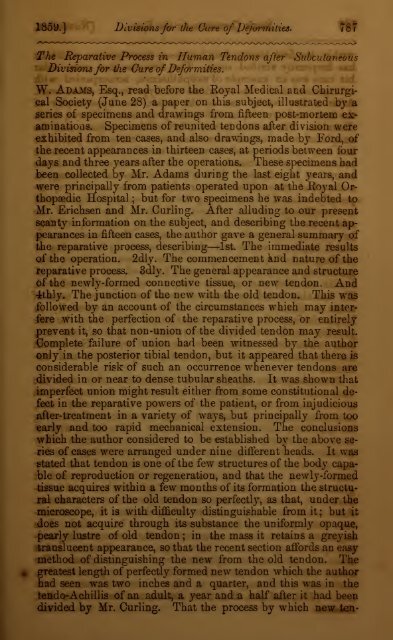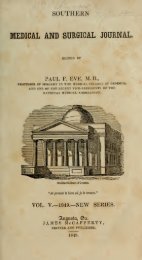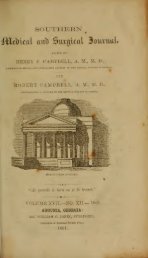—786 Secale Cornutumfor the Eyes. [November,within the first twenty-four hours—a circumstance which hehas frequently verified since. The first case that came underhis care was an example of exophthalmos, accompanied withenlargement of the thyroid gl<strong>and</strong> <strong>and</strong> hypertrophy of the heart.After a few weeks' use of the secale, the hypertrophy ofthe heart <strong>and</strong> thyroid, as well as the projection of the eye, muchdiminish. The patient however left off the medicine, <strong>and</strong> theexophthalmos returned worse than ever. Since that period hehas employed the secale in various cases in which increasingcontractility of the muscles of the bloodvessels or other tissuesseemed to be indicated. It was found of especial advantage ina disturbed state of the accommodation-power of the eye, especiallyinduced by over-taxing the organ on small objects withan insufficient amount of light. Children from some of theschools have furnished the author with many instances, <strong>and</strong> theyhave always been relieved by the secale. He relates a case inwhich impaired vision was always brought on by sewing orreading, <strong>and</strong> wherein the signs of some amount of chronic congestionwere visible. Belief rapidly followed, <strong>and</strong> when the affectionrecurred some months after, it was as speedily relieved.He has also found the secale of great use in several cases ofacute or chronic inflammation of the eye, <strong>and</strong> especially inblepharitis <strong>and</strong> the pustular conjuDctivitis of children, the caseproving much more rapid, <strong>and</strong> relapse being much less rare,than when local means alone are relied upon. No benefithas been derived from it in granular conjunctivitis <strong>and</strong> trachoma.Proceeding upon the theory of its stimulant action upon thevaso-motoric nerves, the author has extended the employmentof the secale to other local disturbances of the economy ;<strong>and</strong>,as already observed, he has had frequent occasions of observingits transitory influence in hypertrophy of the heart, withouthaving any reason to believe that it is of any permanent utilityin affections of this organ, the heart always returning to its formersize soon after the use of the secale has ceased. In manycases of both chronic <strong>and</strong> acute hyperemia it has proved ofgreat service, <strong>and</strong> especially in cases of galactorrhea, <strong>and</strong> in indurations,tumefactions, <strong>and</strong> catarrhal affections of the uterus.Also, it has been very useful in enlarged spleen from intermittentfever, <strong>and</strong> when large doses of quinine have failed. It isespecially indicated in the cases of relapsing intermittent dependingupon enlarged spleen. In erysipelatous affections, it hasoften done good service applied externally as a cataplasm. Theauthor formerly gave ten grains ter die, but now gives but five,combining it with magnesia, or, when chlorosis is present, withChir. Review, <strong>and</strong> Am. Jour, of Med.iron.Sciences.[Brit, <strong>and</strong> For. Med_.
1859.] Divisions for the Cure of Deformities. 787The Reparative Process in Human Tendons after SubcutaneousDivisions for tlie Cure of Deformities.W. Adams, Esq., read before the Royal <strong>Medical</strong> <strong>and</strong> ChirurgicalSociety (June 28) a paper on this subject, illustrated by aseries of specimens <strong>and</strong> drawings from fifteen post-mortem examinations.Specimens of reunited tendons after division wereexhibited from ten cases, <strong>and</strong> also drawings, made by Ford, ofthe recent appearances in thirteen cases, at periods between fourdays <strong>and</strong> three years after the operations. These specimens hadbeen collected by Mr. Adams during the last eight years, <strong>and</strong>were principally from patients operated upon at the Royal OrthopaedicHospital ; but for two specimens he was indebted toMr. Erichsen <strong>and</strong> Mr. Curling. After alluding to our presentscanty information on the subject, <strong>and</strong> describing the recent appearancesin fifteen cases, the author gave a general summary ofthe reparative process, describing—1st. The immediate resultsof the operation. 2dly. The commencement <strong>and</strong> nature of thereparative process. 3dly. The general appearance <strong>and</strong> structureof the newly-formed connective tissue, or new tendon. And4thly. The junction of the new with the old tendon. This wasfollowed by an account of the circumstances which may interferewith the perfection of the reparative process, or entirelyprevent it, so that non-union of the divided tendon may result.Complete failure of union had been witnessed by the authoronly in the posterior tibial tendon, but it appeared that there isconsiderable risk of such an occurrence whenever tendons aredivided in or near to dense tubular sheaths. It was shown thatimperfect union might result either from some constitutional defectin the reparative powers of the patient, or from injudiciousafter-treatment in a variety of ways, but principally from tooearly <strong>and</strong> too rapid mechanical extension. The conclusionswhich the author considered to be established by the above seriesof cases were arranged under nine different heads. It wasstated that tendon is one of the few structures of the body capableof reproduction or regeneration, <strong>and</strong> that the newly -formedtissue acquires within a few months of its formation the structuralcharacters of the old tendon so perfectly, as that, under themicroscope, it is with difficulty distinguishable from it; but itdoes not acquire through its substance the uniformly opaque,pearly lustre of old tendon ; in the mass it retains a greyishtranslucent appearance, so that the recent section affords an easymethod of distinguishing the new from the old tendon. Thegreatest length of perfectly formed new tendon which the authorhad seen was two inches <strong>and</strong> a quarter, <strong>and</strong> this was in thetendo-Achillis of an adult, a year <strong>and</strong> a half after it had beendivided by Mr. Curling. That the process by which new ten-
- Page 1 and 2:
SOUTHERNMEDICAL AND SUBGICAL JOURNA
- Page 3 and 4:
1859.] Climate to the Consumptive,
- Page 5 and 6:
1859.] Climate to the Consumptive,
- Page 7 and 8:
Aug.Oct.1859.] Climate to the Consu
- Page 9 and 10:
1859.] Climate to the Consumptive,
- Page 11 and 12:
1859.] Climate to the Consumptive,
- Page 13 and 14: 1S59.] Climate to tJte Consumptive,
- Page 15 and 16: 1859.] Climate to l/ie Consumptive,
- Page 17 and 18: 1859.] Climate to the Consumptive,
- Page 19 and 20: 1859.] Climate to the Consumptive,
- Page 21 and 22: 1859.] Dugas, on Fracture of Hie Sc
- Page 23 and 24: 1869.] Lecture upon Cerebral Fever.
- Page 25 and 26: • of1859.] Lecture on Cerebral Fe
- Page 27 and 28: 1859.] Lecture on Cerebral Fever. 7
- Page 29 and 30: 1859.] Lecture on Cerebral Fever. 7
- Page 31 and 32: 1859.] Lecture on Gerebral J' 753un
- Page 33 and 34: 1859.] Lecture on Cerebral Ftthey a
- Page 35 and 36: :1859.] Attempted Abortion and Deat
- Page 37 and 38: 1859.] Attempted Abortion and Death
- Page 39 and 40: :—:1859.] Diphtheria. 761by its o
- Page 41 and 42: —:1859.] Diphtheria. 763ride of i
- Page 43 and 44: ——1859.] Diarrhoea of Infants a
- Page 45 and 46: 1859.] Action of Mercury on the Sec
- Page 47 and 48: 1859.] Defective Assimilation in In
- Page 49 and 50: —1859.] Cancerous Ulceration clos
- Page 51 and 52: —1859.] Vegetation of the Genital
- Page 53 and 54: 1859.] Gases of Suppression of the
- Page 55 and 56: 1859.] Cases of Suppression of the
- Page 57 and 58: ——;1859.] After-treatment of th
- Page 59 and 60: 1859.] Dr. 0. C. Gibbs. Summary. 78
- Page 61 and 62: 1859.] Dr. 0. C. GrBBS. Summary, 78
- Page 63: :;1859.] Secale Cornulam for t?ie E
- Page 67 and 68: ;1859.] Incision in Anthrax. 789Inc
- Page 69 and 70: :;1859.] Editorial and Miscellaneou
- Page 71 and 72: ———and1859.] Miscellaneous. 7








